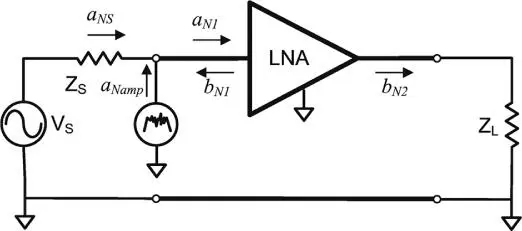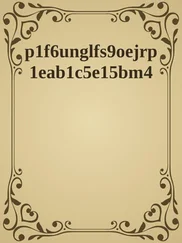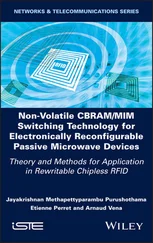Recently more advanced techniques have been developed and made practical based on incident noise power and gain. If the impedance is known, the incident noise power can be computed as in Eq. (1.59); and if the output incident noise power N OEcan be measured, then one can compute the output available noise as
(1.60) 
Substituting into Eq. (1.57)to find
(1.61) 
When the source is a matched source, this simplifies to
(1.62) 
Thus, for a simple system of an amplifier sourced with a Z 0impedance and terminated with a Z 0load, the noise factor can be computed simply from the noise power measured in the load and the S21 gain. However, Eq. (1.61)defines the noise figure of the amplifier in terms of the source impedance, and this is a key point. In general, although the 50 Ω noise figure is the most commonly quoted, it is measured only when the source impedance provided is exactly 50 Ω. In the case where the source impedance is not 50 Ω, the 50‐Ω noise figure cannot be simply determined.
Because of the common factor of temperature in many noise figure computations, the noise power is sometimes redefined as available noise temperature.
(1.63) 
From this definition, the noise factor becomes
(1.64) 
where T RNAis the relative available noise temperature, expressed in Kelvin above 290 K.
1.5.2 Effective or Excess Input Noise Temperature
For very low noise figure devices, it is often convenient to express their noise factor or noise figure in terms of the excess power that would be at the input due to a higher temperature generator termination, which would result in the same available noise temperature at the output. This can be computed as
(1.65) 
Thus, an ideal noiseless network would have a zero input noise temperature, and a 3 dB noise figure amplifier would have a 290 K excess input noise temperature, or 290 K above the reference temperature.
1.5.3 Excess Noise Power and Operating Temperature
For an amplifier under test, the noise power at the output, relative to the kTB noise power, is called the excess noise power , P NE, and is computed as
(1.66) 
For a matched source and load, it is the excess noise, above kTB, that is measured in the terminating resistor and can be computed as
(1.67) 
which is sometimes called the incident relative noise or RNP I(as opposed to available, or RNP). Errors in noise figure measurement are often the result of not accounting properly for the fact that the source or load impedances are not exactly Z 0. A related parameter is the operating temperature, which is analogous to the input noise temperature at the amplifier output, and is computed as
(1.68) 
While the effect of load impedance may be overcome with the use of available gain, which is independent of load impedance, the effect of source impedance mismatch must be dealt with a much more complicated way, as shown next.
1.5.4 Noise Power Density
The excess noise is measured relative to the kTB noise floor and is expressed in dBc relative to the T 0noise floor. However, the noise power could also be expressed in absolute terms such as dBm. But the measured noise power depends upon the bandwidth of the detector, and so the noise power density provides a reference value with a bandwidth equivalent to 1 Hz. Thus, the noise power density is the related to the excess noise by
(1.69) 
The formal definition of noise figure for an amplifier defines the noise figure only for the impedance or reflection coefficient of current source termination, but this noise figure is not the 50‐Ω noise figure. Rather, it is the noise figure of the amplifier for the impedance of the source. In general, one cannot compute the 50 Ω noise figure from this value without additional information about the amplifier. If one considers the amplifier in Figure 1.5, with internal noise sources, the effect of the noise sources is to produce noise power waves that may be treated similarly to normalized power waves, a and b .

Figure 1.5 An amplifier with internal noise sources.
The source termination produces an incident noise wave a NSand adds to the internal noise created in the amplifier, which can be represented as an input noise source a Namp. There are scattered noise waves represented by the noise emitted from the input of the amplifier, b N1, and the noise incident on the load is b N2. From this figure, one can make a direct comparison to the S‐parameters and see that reflected noise power might add or subtract to the incident noise power and affect the total noise power. However, at the input of the amplifier, the noise generated inside the amplifier is in general not correlated with the noise coming from the source termination so that they don't add together in a simple way. Because of this, the noise power at the output of the amplifier, and therefore the noise figure, depends upon the source impedance in a complex way. This complex interaction is defined by two real valued parameters and one complex parameter, known collectively as the noise parameters . The noise figure at any source reflection coefficient may be computed as
(1.70) 
Читать дальше
























